Monterey Bay, situated a bit south of the bustling San Francisco Bay Area, is a year-round paradise for those eager to witness the majestic whales in their natural setting. Not just in one season, but every single month, you have over a 90% chance of spotting a whale here. This is thanks to the overlapping feeding and migrating seasons. Protected since 1992, this marine sanctuary is home to a rich variety of marine life.
In this article, we will explore the list of amazing whales you have a chance to spot in Monterey Bay. Let’s begin!
1. Blue Whale (Balaenoptera musculus)

Yep, you can see blue whales in Monterey Bay!
©Andrew Sutton/Shutterstock.com
Imagine witnessing the largest animal that has ever inhabited our planet right here in Monterey Bay! That’s right! Spotting blue whales in this region is not uncommon.
Blue whales are known for their elongated bodies and sleek form. When underwater, their blue-gray complexion transforms into a light blue hue, giving them their name, the blue whale. Interestingly, markings vary between individuals, making them identifiable — much like fingerprints.
These magnificent sea giants dominate the world’s oceans. They boast a staggering length of up to 110 feet and a massive weight that can exceed 200 tons. It’s astounding to think that their tongues can weigh as much as an elephant. And their hearts can tip the scales at the weight of a car!
Despite their enormous size, they primarily feed on krill, minuscule shrimp-like creatures no larger than a small fingernail. Except in the Arctic, you can find blue whales in every ocean. While they usually migrate between their summer feeding and winter mating locations, there’s data to suggest that some groups may not migrate at all.
Around 2,200 blue whales have been documented in the vicinity of California. Unfortunately, they are an endangered species, with their global population hovering around 10,000 to 25,000. However, the group in the Californian waters seems to be the most healthy and considerable population globally.
Where and When to Spot Blue Whales in Monterey Bay
Despite their prevalence in these waters, spotting blue whales from the shore is a rarity. They prefer to forage and travel away from the coast. Your best chance of seeing them is to join a whale-watching cruise, with several options available in Monterey Bay.
Within Monterey Bay, blue whales are frequently observed near the edges of the submarine canyon, a favorite gathering spot for krill. The best time to witness these gentle giants is from May to October. But you’ll have the best chance between July and August, when the krill population is abundant.
2. Killer Whale (Orcinus orca)
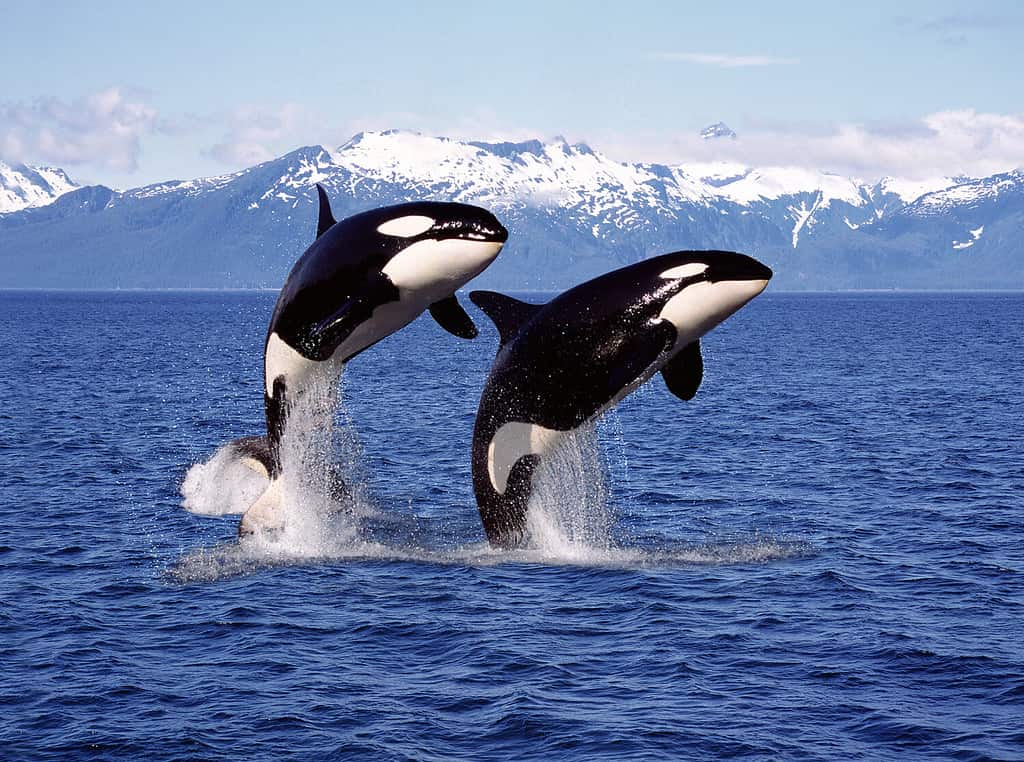
Killer whales, or orcas, can also be found in Monterey Bay.
©slowmotiongli/Shutterstock.com
In Monterey Bay, you have the unique opportunity to witness three distinct genetic variations of killer whales. Those that predominantly feed on mammals (transient type), the ones that prefer fish and sharks (offshore type), and the group that has a preference for salmon, known as the Southern resident killer whales.
Identifiable by their black upper bodies complemented by white undersides and eye patches, they also sport a gray or white patterned area behind their dorsal fins. These characteristics can vary greatly among individual whales and different groups.
Mature male killer whales can attain a size ranging between 20 and 27 feet. The females are slightly smaller in comparison. These apex predators not only feast on fish and squid but are also known to prey on seals, seabirds, and even larger whale species. They have established their presence in every ocean globally.
Where and When to Spot Killer Whales in Monterey Bay
Throughout the year, killer whales are spotted in the Monterey Bay region. They make appearances typically 2 to 5 times monthly in groups consisting of around 8 to 20 members. The transient type is the one most commonly sighted in the area.
The best time for encountering killer whales in Monterey Bay is between mid-April and mid-May or from the end of August to October. A tell-tale sign of their presence in the vicinity might be a noticeable decrease in sea life or observed erratic movements of dolphins and sea lions as they try to evade their formidable predator.
3. Gray Whale (Eschrichtius robustus)
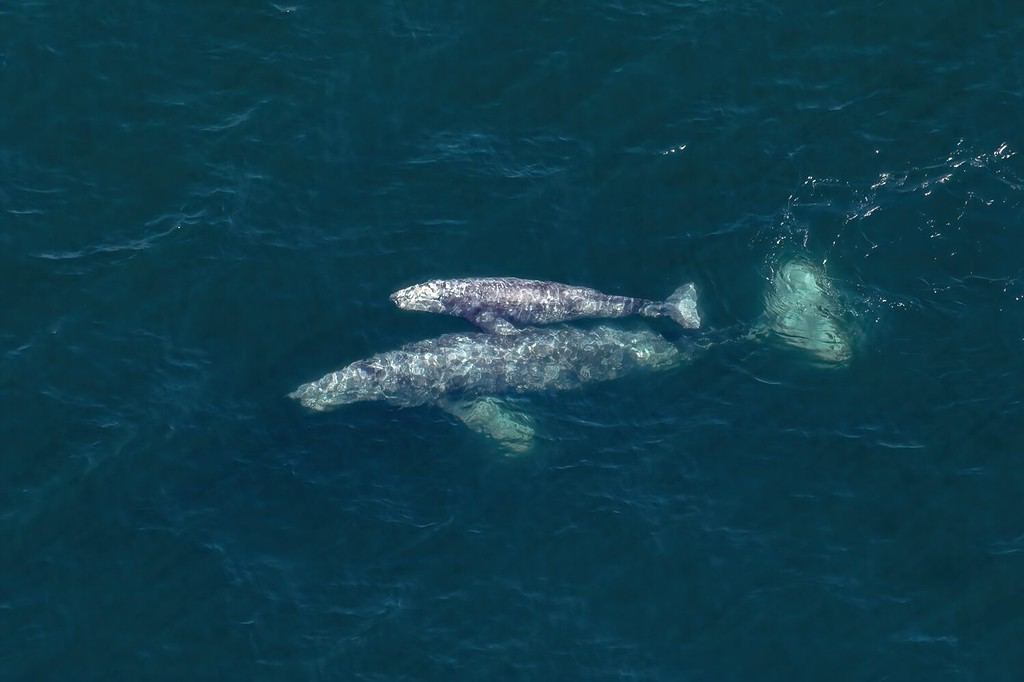
You can see gray whales in Monterey Bay in winter and spring.
©Travis Potter/Shutterstock.com
Each winter and spring, the entire population of gray whales undertakes a monumental journey past the shores of Monterey. This incredible migration sees them cover more than 12,000 miles. They move from the Bering Sea, their summer residence, to the warm breeding grounds in Baja California, only to return again.
Distinguished by a distinctive hump and a series of rugged protrusions along their back instead of a dorsal fin, these gray whales are indeed a sight to behold. They belong to the baleen whale category, characterized by a unique feeding mechanism that involves filtering nourishment from water using bristle-like structures in their mouths.
Growing up to an impressive 49 feet and weighing around 90,000 pounds, these enormous creatures are truly magnificent. Their diet is quite diverse. They eat various crustaceans such as ghost shrimp and amphipods, in addition to herring eggs, worms, and different larvae.
Where and When to Spot Gray Whales in Monterey Bay
To witness these whales in Monterey Bay, plan your visit between December and mid-April, a period when they flock to the warmer waters. If you are lucky, between December and February, you might spot the newly born calves. These calves are always eager to explore their surroundings, often venturing close to boats with their mothers, offering an unforgettable experience.
Monterey Bay is a prime location on the Californian coast to admire gray whales. This is primarily due to the submarine canyon nearby. This canyon allows these whales to be spotted merely a few miles off the coast.
4. Humpback Whale (Megaptera novaeangliae)
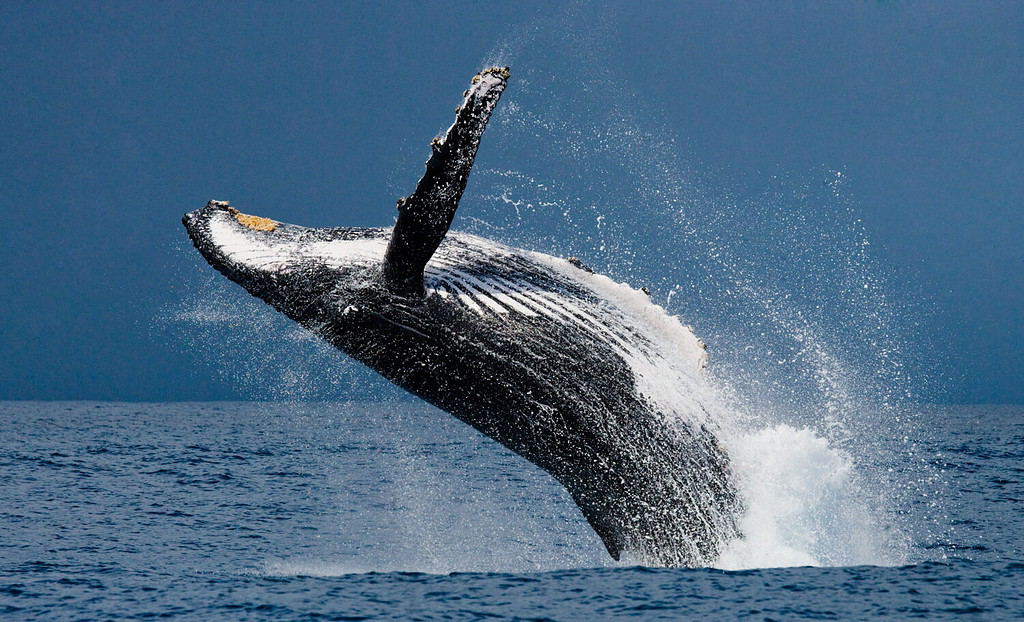
Humpback whales can grow up to 60 feet long.
©GUDKOV ANDREY/Shutterstock.com
During the seasons of spring, summer, and fall, humpback whales leave their cozy winter breeding sites near Central America to grace the nutritious waters of Monterey Bay with their presence.
Recognizable by their dark gray or black bodies, these whales boast white patches on their bellies, under their tail flukes, and on their pectoral fins. Much like human fingerprints, each whale’s distinct black-and-white patterns are unique to the individual.
Capable of growing to 60 feet and weighing around 80,000 pounds, humpback whales are formidable carnivores. They sustain themselves on a diet of krill and a variety of small fish, including haddock, herring, and salmon, residing in waters ranging from polar to tropical regions.
In Monterey Bay, these whales provide a vivid display of their feeding techniques, which can involve lunge feeding at the surface or diving deep to find concentrated groups of prey. Known as the most animated members of the baleen whale family, they are often witnessed engaging in a range of activities such as breaching, spyhopping, and tail lobbing.
When and Where to Spot Humpback Whales in Monterey Bay
Monterey Bay is a special place for whale watchers aiming to spot humpbacks, thanks to the proximity of the submarine canyon to the shoreline. This geological feature serves as a magnet for these whales, drawing them to the edges where their food is abundant.
Ideal locations to witness this natural spectacle include Asilomar State Beach, the vicinity of Point Sur Lighthouse, and areas near Highway 1. Moss Landing’s beaches, situated at the Monterey Submarine Canyon’s entrance, offer another prime viewing spot.
While humpbacks are typically sighted solo or in pairs, it’s not uncommon to encounter groups of 40 to 50 individuals congregating in areas with plentiful food supplies. If you’re planning a visit, the period from March to November is ideal. But note that the highest frequency of sightings occurs in July and August.
5. Minke Whale (Balaenoptera acutorostrata)

One of the most likely whales you’ll come across in Monterey Bay is the minke whale.
©Tim Watters/Shutterstock.com
All year round, Monterey Bay is home to the captivating minke whales! Sporting a tall, curved dorsal fin positioned approximately two-thirds along their back, minke whales are a magnificent sight. Their dark gray or brownish-black body is marked with a light chevron pattern near the head and above the flippers, contrasting beautifully with their white underbelly.
Being the smallest among the baleen whales found in North American waters, minke whales generally grow up to a length of about 35 feet. Females are a bit larger than their male counterparts.
These creatures have a varied diet, including small crustaceans, plankton, and schools of small fish. While they favor temperate to boreal waters, you might also spot them in tropical and subtropical zones.
Where and When to Spot Minke Whales in Monterey Bay?
In Monterey Bay, minke whales are a common sight throughout the year, particularly during the summertime and the fall season. They usually roam the nearshore rocky regions, hunting juvenile rockfishes.
You can often find them inhabiting the areas near the southern parts of Monterey Bay and the shores of Big Sur. Spotting minke whales can be a bit challenging since they usually swim solo, have a fleeting presence on the water’s surface, and emit a barely noticeable blow spout.
Despite their elusive nature, when seen, they often exhibit fascinating behaviors like breaching, spy hopping, or even leaping out of the water entirely. To increase your chances of witnessing these graceful creatures, consider joining a whale-watching boat tour, which offers the best chance for sightings.
6. Fin Whale (Balaenoptera physalus)
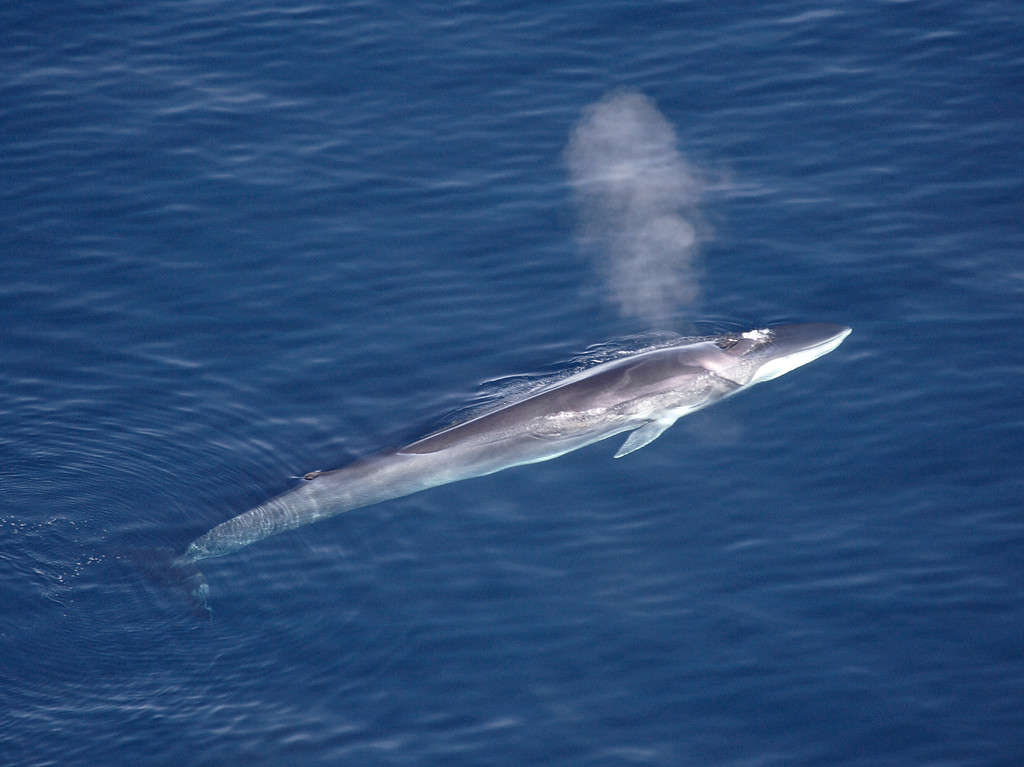
The second-largest whale in the world, the fin whale, visits Monterey Bay in the summer and fall.
©Aqqa Rosing-Asvid – Visit Greenland, CC BY 2.0 – License
While the blue whale often steals the spotlight in Monterey Bay, you might be fortunate enough to witness the sight of the equally striking fin whale, the second-largest whale species.
These whales boast a unique color pattern, with a dark brownish-gray or black back and sides, contrasting sharply with their white underbelly. Their head exhibits a remarkable asymmetric color, as the left lower jaw appears dark, while the right side is white, a pattern inverted on the tongue.
Male fin whales typically measure around 70 feet and weigh about 45 tons. On the other hand, females can stretch up to 73 feet and share the same weight range. Their diet mainly consists of krill, tiny shoaling fish, and squid. Preferring deep, open waters across all major oceans, they usually gravitate towards temperate to colder regions.
When and Where to Spot Fin Whales in Monterey Bay?
During the summer and fall months, you might spot fin whales in Monterey Bay and its nearby waters, though they are more frequently seen further from the coastline.
Given their infrequent visits, pinpointing an exact time and place for a sighting can be challenging. Nonetheless, going on a whale-watching boat expedition might be your golden ticket to spotting these elusive giants, as they usually prefer to keep a distance from the shoreline.
7. Baird’s Beaked Whale (Berardius bairdii)
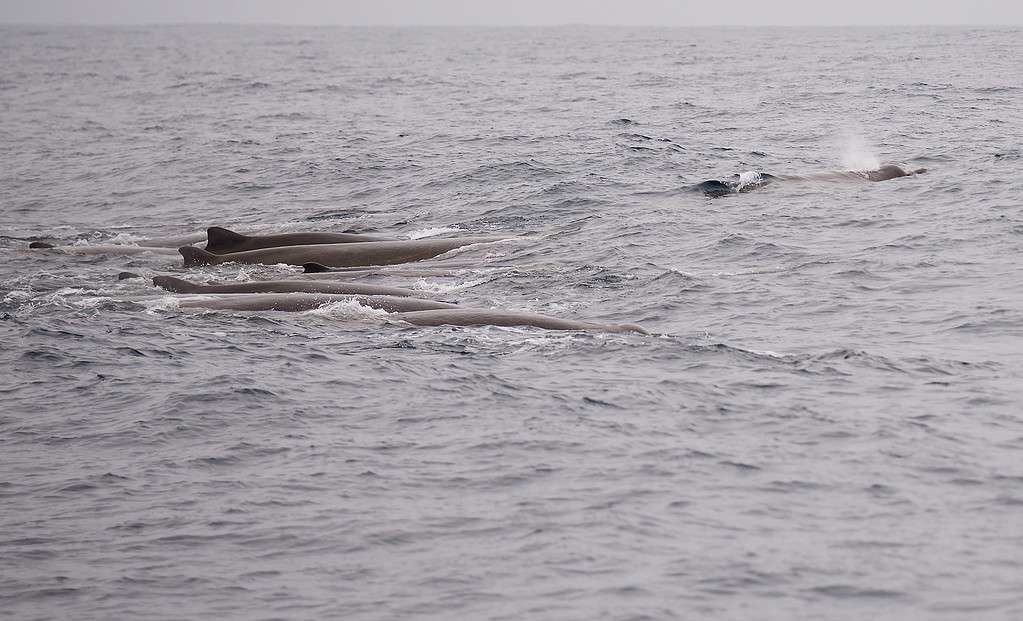
A rare whale you might be able to spot in Monterey Bay is the Baird’s beaked whale.
©Steve Peck / CC BY 2.0 – License
The Baird’s beaked whale is a rare visitor to Monterey Bay. These whales boast a sturdy, elongated, and slender physique, characterized by a petite, rounded dorsal fin positioned about two-thirds down their back, giving them a distinctive appearance.
Among the beaked whale family, Baird’s beaked whales are the largest. Females typically measure up to 36 feet, and males are slightly shorter at around 35 feet.
These whales primarily feast on a diet comprising deep-sea and pelagic fish such as mackerel, sardines, crustaceans, squid, and octopus. Their habitat spans the West Coast of the United States, from California to the chilly waters of Alaska.
When and Where to Spot Baird’s Beaked Whales in Monterey Bay
These deep-sea dwellers are known for their extended diving abilities, typically forming compact groups and thus are infrequently spotted. In Monterey Bay, your chances of witnessing these creatures are higher during the fall season.
Considering their deep-water habitat, your best shot at catching a glimpse of these rare whales is by joining a whale-watching boat tour in Monterey Bay. Keep in mind, though, that spotting them requires a stroke of luck!
Rare Whale Visitors in Monterey Bay

While uncommon, you might be able to spot sperm whales (pictured), sei whales, and Cuvier’s beaked whales in Monterey Bay.
©wildestanimal/Shutterstock.com
If you’re very lucky, you can spot some of the rare visitors of Monterey Bay. Let’s take a closer look at these whales that rarely pop by for a visit in these beautiful waters!
Sperm Whale (Physeter macrocephalus): These colossal creatures are the giants among toothed whales, with males stretching up to 60 feet and females measuring around 37 feet. Exhibiting a dark gray hue, they boast a distinct hump instead of a dorsal fin and sport triangular tails.
Sightings of this whale in Monterey Bay are extremely rare, occurring roughly once every 5 years.
Sei Whale (Balaenoptera borealis): Recognizable by their slender bodies and compressed tail stocks that merge sharply with the flukes, sei whales are a rare sight in the Monterey Bay waters. Adult males typically measure about 46 feet and weigh around 14 tons, while females can be slightly larger, about 49 feet long.
These whales are usually found farther offshore, with only a few documented sightings in Monterey Bay.
Cuvier’s Beaked Whale (Ziphius cavirostris): These medium-sized whales have rounded, sturdy bodies with distinctive triangular dorsal fins situated far along their backs. They can grow between 15 and 23 feet in length.
The West Coast of North America is home to an estimated 5,000 individuals, with Monterey Bay being one of the few coastal regions offering the deep waters these whales prefer.
Summary of Amazing Whales You Might Spot in Monterey Bay
| Number | Whale | Scientific Name |
|---|---|---|
| 1. | Blue Whale | Balaenoptera musculus |
| 2. | Killer Whale | Orcinus orca |
| 3. | Gray Whale | Eschrichtius robustus |
| 4. | Humpback Whale | Megaptera novaeangliae |
| 5. | Minke Whale | Balaenoptera acutorostrata |
| 6. | Fin Whale | Balaenoptera physalus |
| 7. | Baird’s Beaked Whale | Berardius bairdii |
| 8. | Sperm Whale | Physeter macrocephalus |
| 9. | Sei Whale | Balaenoptera borealis |
| 10. | Cuvier’s Beaked Whale | Ziphius cavirostris |
The photo featured at the top of this post is © GUDKOV ANDREY/Shutterstock.com
Thank you for reading! Have some feedback for us? Contact the AZ Animals editorial team.






